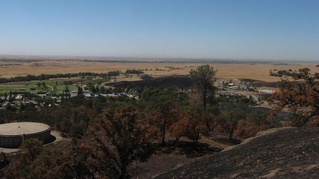 Looking down at the college from within the refuge. Butte College sits within a 928 acre wildlife refuge that not only makes a great instructional aid, but also provides a terrific place to relax and commune with nature. There are over 300 species of plants, but unfortunately, that number includes non-natives. The campus's Clear Creek anchors a riparian ecosystem that is being restored by Friends of the Refuge and other college staff.
Looking down at the college from within the refuge. Butte College sits within a 928 acre wildlife refuge that not only makes a great instructional aid, but also provides a terrific place to relax and commune with nature. There are over 300 species of plants, but unfortunately, that number includes non-natives. The campus's Clear Creek anchors a riparian ecosystem that is being restored by Friends of the Refuge and other college staff.
Much of the undeveloped campus, within the buttes, is home to blue oaks. They thrive in dry climates. The valley oaks, however, typically can only survive within the influence of a stream (Clear Creek in this case). In addition, you can find the Grey Pine in a few places and there's at least one healthy Elderberry near Maidu Butte. The Elderberry is protected since the Valley Elderberry Longhorn Beetle is endangered.
But it's not just a refuge for wildlife — there's also a "cave" that was once used by transient Native Americans on the north end of Maidu Butte.
Many students don't know that most of the campus is open to hiking. For students that are interested in taking advantage of Butte College's unique location, Friends of the Refuge regularly hikes the campus. Of course, the usual cautions apply: beware of electrified fences (cattle graze at Butte!), mountain lions (rare), rattle snakes (very common), and ticks (extremely common during spring). Of course, when driving on to campus, always yield to squirrels, rabbits, deer, and any other critters.
A lesser known part of campus is the "Lost Campus", the location of a few effluent ponds and home to more wildlife.
Trails
- On the south-east end of the campus complex, there is a 1-mile long trail loop. It follows Clear Creek, and there are interpretive signs along most of it.
- The gate just north of the Allied Health Public Services building leads to Water Tower Butte and is a common gateway to other trails (more details soon...).
Conservation
Currently there are many invasive species of plants and animals that thrive on the refuge. For example, around six years ago, much of the forked creeks (E. & W. Clear Creek?) that run through the refuge would have been nearly inaccessible because of the English Blueberry. Through employment of ever-hungry goats and spot applications of herbicides, the invasive plants are now relegated to the south-west end of Clear Creak. This spring, the shrubs may well vanish through efforts of Butte College staff.
In addition, invasive wild grasses are being dealt with by way of selective burns by the California Department of Forestry. Then, staff (often instructors) seed the land with native grasses, such as the Creeping Wild Rye.
Students, as part of their classwork, also have the opportunity to plant native species such as the California Buckeye. Students also have the opportunity to join the Friends of the Wildlife Refuge club and participate in rehabilitating a small section of the refuge.
Besides plants, however, there is another major invasive species that represents a serious problem. That is the bullfrog. The bullfrog will eat anything that it can get its jaws around, which means many small native animals are threatened. The bullfrog also reproduces very fast, making it an especially hazardous invasive species.
Animals
Many animals find their home on the refuge. Through study of tracks and scat, Butte College staff and students have a fair idea as to what. To name a few: Black bears, coyotes, foxes, beavers, and even mountain lions. However, many rarely (if ever) come down to the complex. There are some animals, however, that certainly do make their rounds for any morsels of food left by students.
Plants
Clear Creek Riparian Community
- California Buckeye
- Willow
- Valley Oak
- Mint
- Pipevine
- California Bay
- Coffee Berry
- Elderberry (reintroduced)
- Humboldt Lily
Humboldt Fire
 Humboldt Fire from Water Tower Butte The Humboldt fire burned a few hundred acres of the refuge's north and western areas. The Blue Oaks that predominate those areas actually like fire and most of them will survive. The Gray Pines, however, seemed to have taken quite a beating. But they actually require fire to help reproduce. Fire opens their cones which aids the distribution of seeds.
Humboldt Fire from Water Tower Butte The Humboldt fire burned a few hundred acres of the refuge's north and western areas. The Blue Oaks that predominate those areas actually like fire and most of them will survive. The Gray Pines, however, seemed to have taken quite a beating. But they actually require fire to help reproduce. Fire opens their cones which aids the distribution of seeds.
The fire was contained, for the most part, at Butte College Drive by fire fighters. None of the college's infrastructure was destroyed due to their heroic efforts. The situation may have been different, however, if Butte College had not been used as a fire camp at the time.
A full survey of the fire's damage to the environment has yet to be undertaken. For example, fire can cause severe erosion issues which can be mitigated using straw or other materials. In addition, the college may want to try to use the fire as an opportunity to reintroduce native grasses in hopes to displace the nonnatives.


